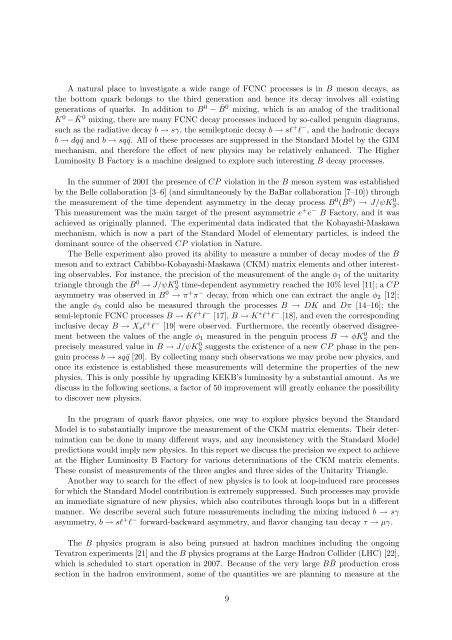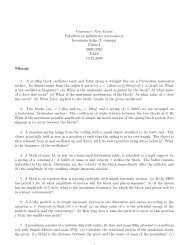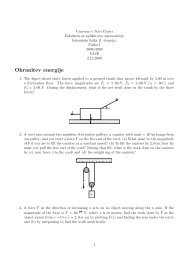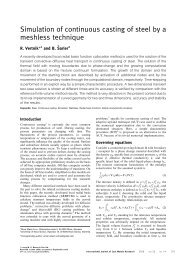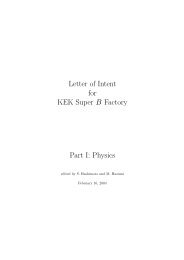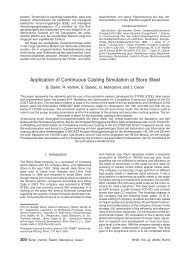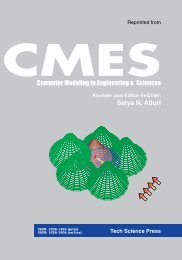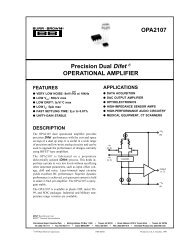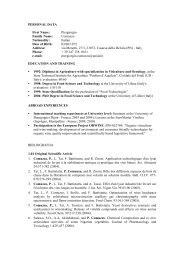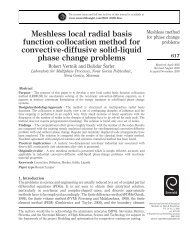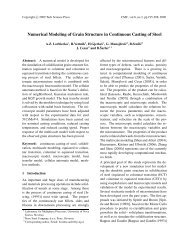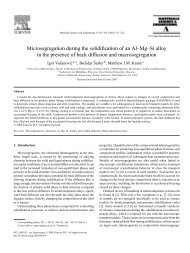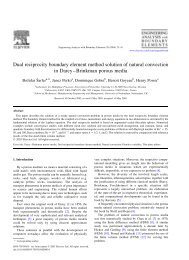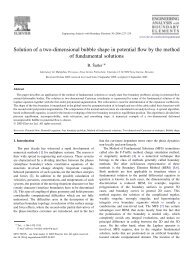Letter of Intent for KEK Super B Factory Part I: Physics
Letter of Intent for KEK Super B Factory Part I: Physics
Letter of Intent for KEK Super B Factory Part I: Physics
You also want an ePaper? Increase the reach of your titles
YUMPU automatically turns print PDFs into web optimized ePapers that Google loves.
A natural place to investigate a wide range <strong>of</strong> FCNC processes is in B meson decays, as<br />
the bottom quark belongs to the third generation and hence its decay involves all existing<br />
generations <strong>of</strong> quarks. In addition to B 0 − ¯ B 0 mixing, which is an analog <strong>of</strong> the traditional<br />
K 0 − ¯ K 0 mixing, there are many FCNC decay processes induced by so-called penguin diagrams,<br />
such as the radiative decay b → sγ, the semileptonic decay b → sℓ + ℓ − , and the hadronic decays<br />
b → dq¯q and b → sq¯q. All <strong>of</strong> these processes are suppressed in the Standard Model by the GIM<br />
mechanism, and there<strong>for</strong>e the effect <strong>of</strong> new physics may be relatively enhanced. The Higher<br />
Luminosity B <strong>Factory</strong> is a machine designed to explore such interesting B decay processes.<br />
In the summer <strong>of</strong> 2001 the presence <strong>of</strong> CP violation in the B meson system was established<br />
by the Belle collaboration [3–6] (and simultaneously by the BaBar collaboration [7–10]) through<br />
the measurement <strong>of</strong> the time dependent asymmetry in the decay process B 0 ( ¯ B 0 ) → J/ψK 0 S .<br />
This measurement was the main target <strong>of</strong> the present asymmetric e + e − B <strong>Factory</strong>, and it was<br />
achieved as originally planned. The experimental data indicated that the Kobayashi-Maskawa<br />
mechanism, which is now a part <strong>of</strong> the Standard Model <strong>of</strong> elementary particles, is indeed the<br />
dominant source <strong>of</strong> the observed CP violation in Nature.<br />
The Belle experiment also proved its ability to measure a number <strong>of</strong> decay modes <strong>of</strong> the B<br />
meson and to extract Cabibbo-Kobayashi-Maskawa (CKM) matrix elements and other interest-<br />
ing observables. For instance, the precision <strong>of</strong> the measurement <strong>of</strong> the angle φ1 <strong>of</strong> the unitarity<br />
time-dependent asymmetry reached the 10% level [11]; a CP<br />
triangle through the B0 → J/ψK0 S<br />
asymmetry was observed in B0 → π + π− decay, from which one can extract the angle φ2 [12];<br />
the angle φ3 could also be measured through the processes B → DK and Dπ [14–16]; the<br />
semi-leptonic FCNC processes B → Kℓ + ℓ− [17], B → K∗ℓ + ℓ− [18], and even the corresponding<br />
inclusive decay B → Xsℓ + ℓ− [19] were observed. Furthermore, the recently observed disagreement<br />
between the values <strong>of</strong> the angle φ1 measured in the penguin process B → φK0 S and the<br />
precisely measured value in B → J/ψK0 S suggests the existence <strong>of</strong> a new CP phase in the pen-<br />
guin process b → sq¯q [20]. By collecting many such observations we may probe new physics, and<br />
once its existence is established these measurements will determine the properties <strong>of</strong> the new<br />
physics. This is only possible by upgrading <strong>KEK</strong>B’s luminosity by a substantial amount. As we<br />
discuss in the following sections, a factor <strong>of</strong> 50 improvement will greatly enhance the possibility<br />
to discover new physics.<br />
In the program <strong>of</strong> quark flavor physics, one way to explore physics beyond the Standard<br />
Model is to substantially improve the measurement <strong>of</strong> the CKM matrix elements. Their determination<br />
can be done in many different ways, and any inconsistency with the Standard Model<br />
predictions would imply new physics. In this report we discuss the precision we expect to achieve<br />
at the Higher Luminosity B <strong>Factory</strong> <strong>for</strong> various determinations <strong>of</strong> the CKM matrix elements.<br />
These consist <strong>of</strong> measurements <strong>of</strong> the three angles and three sides <strong>of</strong> the Unitarity Triangle.<br />
Another way to search <strong>for</strong> the effect <strong>of</strong> new physics is to look at loop-induced rare processes<br />
<strong>for</strong> which the Standard Model contribution is extremely suppressed. Such processes may provide<br />
an immediate signature <strong>of</strong> new physics, which also contributes through loops but in a different<br />
manner. We describe several such future measurements including the mixing induced b → sγ<br />
asymmetry, b → sℓ + ℓ − <strong>for</strong>ward-backward asymmetry, and flavor changing tau decay τ → µγ.<br />
The B physics program is also being pursued at hadron machines including the ongoing<br />
Tevatron experiments [21] and the B physics programs at the Large Hadron Collider (LHC) [22],<br />
which is scheduled to start operation in 2007. Because <strong>of</strong> the very large B ¯ B production cross<br />
section in the hadron environment, some <strong>of</strong> the quantities we are planning to measure at the<br />
9


